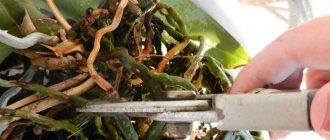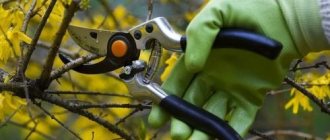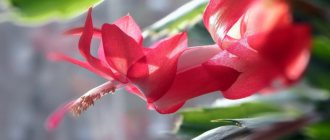Before we knew it, summer had already died down. The bright summer flowers have bloomed, and it’s time to prepare the hydrangeas for the next season. Now these luxurious garden beauties need pruning, cleaning and preparation for winter.
Hydrangea is pruned in autumn or spring. In addition to the time of year, the timing of hydrangea pruning is also influenced by its varietal variety. Conventionally, all varieties of shrubs can be divided into two categories.
- Hydrangeas with flower buds forming on last year's shoots. The first category includes the following types of hydrangeas: liana-shaped, large-leaved, oak-leaved. These plants are not resistant to frost, so it is advisable to prune them in the spring, when the difference between living and frozen shoots is clearly visible. Grooming these species in the fall is particularly delicate and is more of a “cosmetic” measure.
- Hydrangeas with flower buds on the current year's shoots are paniculate and tree-like hydrangeas. In autumn, you can do thinning and sanitary cutting, as well as cutting for flowering.
Pruning hydrangeas in the fall, regardless of category, consists of removing the faded part of the bush - spherical or cone-shaped inflorescences that are easily distinguishable. The advantages of autumn pruning are that there are no tight deadlines for the procedure.
Why prune hydrangea, when and how to do it correctly
The pruning procedure for hydrangea is carried out so that the inflorescences in the future will be large and the bush will delight with lush flowering. If you do not cut off unnecessary inflorescences, then the bush itself will become quite thickened, which will lead to the formation of small flowers. In addition, it is used to ensure that the grower has the opportunity to form a bush of the desired shape. For the purpose of shaping, you need to remove only all those inflorescences that are very small. As a result, the gardener grows only powerful and lush shoots or just 1 standard.
Other nuances that indicate the need for regular pruning include:
- giving the bush a beautiful decorative appearance;
- formation of the correct shape;
- obtaining full and large flowers;
- the ability to turn an ordinary bush into a standard plant.
Did you know? By adjusting the alkalinity and acidity of the soil, each gardener can independently control the color saturation of the hydrangea.
In addition to the question of why to prune hydrangea, people often ask when, namely in what time period it will be correct to implement this procedure.
The peculiarity of such a plant is that it is pruned during the following periods:
- in autumn;
- in spring;
- in summer.
Depending on the purpose of pruning, a specific period is selected during which this action will be carried out. Autumn is the best period for pruning tree and paniculate hydrangeas . This can be done even after the very first frost has passed. This is due to the fact that with the sudden onset of cold weather, the leaves from the plant will quickly fall off and only bronze dry inflorescences will remain. This way, you can quickly determine which shoots you should get rid of and which ones you should leave.
Video: Pruning tree hydrangea in autumn
Therefore, in the autumn season, the best period is considered to be the end of October or the beginning of November . As for a season like spring, during this period it is also possible to prune both tree and paniculate hydrangeas. But it is better if this action is carried out in several stages: one part is cut off in the fall, and the second in the onset of spring. Only spring pruning should be done for large-leaved hydrangeas.
Important! After autumn pruning of inflorescences, it is very important to prepare the hydrangea shrub for future wintering.
Summer is considered an infrequently used period, but during this season such manipulations are carried out if the gardener wants to constantly care for the appearance of the plant and thereby rejuvenate it. Winter is the season in which you should avoid pruning any type of hydrangea . Before cutting shoots on a plant such as hydrangea, you need to decide what species grows on your site, since this determines not only the period of the year in which this action should be performed, but also the rules by which it should be carried out these manipulations.
Among all the types, the following can be distinguished:
- large-leaved;
- ground cover;
- paniculata;
- tree-like.
The large-leaved species blooms on last year's shoots, so from the very beginning of autumn they begin the process of laying shoots . Therefore, large-leaf hydrangeas are often pruned for sanitary purposes. At the same time, bushes that are too dense are thinned out, those shoots that are damaged and inflorescences that have withered or dried out are eliminated. Ground cover is also not subject to deep pruning . In order for its development to occur normally, every year you only need to take care of shortening those shoots that are too long.
Did you know? The homeland of hydrangea is Japan, namely the mountainous regions located in the area of the Japanese islands.
Tree-like and paniculate types of hydrangea are most common, which is why the main process of pruning them is carried out in the spring . It is worth paying attention to the fact that the more often this procedure is performed, the more successful the flowering of the plant will be. Depending on the weather conditions, the period depends, which can start from the beginning of March to the beginning of April.
Types of pruning
When caring for hydrangea, a variety of trimmings can be used, which should be considered in detail:
- Formative - carried out in the very first years of the plant’s life. During the first three years after the hydrangea has been planted, pruning must be done to form an element such as the crown. Particular attention should be paid to the skeletal branches that act as support.
- Regulating - this type is also called stimulating, as it makes it possible to create a beautiful and lush garden bush with the probability of the longest possible flowering. This type of pruning will be ideally combined with thinning, since hydrangea tends to thicken.
- Rejuvenating is a must-have, helping to cope with old and dried branches that can interfere with the growth of young shoots.
- Sanitary - pruning that occurs in the autumn, when the plant has already faded. Such annual care will allow you to get rid of old, diseased, damaged and broken branches. Radical sanitary pruning is necessary in cases where the hydrangea is seriously ill.
Radical rejuvenation
Old hydrangea bushes, as well as those plants that have suffered from diseases and pests, are in a neglected or depressed state, can be rejuvenated in a more radical way. Such hydrangeas are cut “on the stump”, affecting not young growths, but perennial wood.
Usually, for hydrangeas, the cutting method is used to a height of 50-80 cm. After rejuvenation, the hydrangea will miss one flowering season, but the bushes will resume again and form an attractive crown.
Pruning bush hydrangea. © fancyflora
Pruning after flowering
As soon as the hydrangea begins to bloom, you need to think about its future pruning. Many gardeners are confident that the more often this process is carried out, the thicker and more magnificent the plant will bloom. But at the same time, it is worth paying attention to the fact that this is not good for every species, since large-leaved varieties cannot be pruned too much, while tree-like and paniculate varieties require a similar procedure.
Important! to prune
(not form) hydrangeas that are not 2-3 years old.
Should I trim it?
When asking the question whether it is necessary to prune a hydrangea, one can unequivocally answer that this process is necessary depending on the type and variety that the gardener is faced with . Large-leaved hydrangea blooms on last year's shoots, so those new branches that grew in the summer season must overwinter so that their flowering can be observed next year.
If we consider paniculate and tree hydrangeas, then they flower only on annual stems. And if you prune them after flowering, then next year you can get many new shoots with a huge number of flowers.
Video: How to prune hydrangea
How to trim correctly
A very important nuance that should be followed is compliance with the rules for pruning hydrangeas. The best time for this is spring, but in this case you need to be extremely careful, since juice may still be fermenting in the shoots . In this regard, gardeners believe that it is better to do this procedure the other way around in the fall.
Did you know? Interestingly, January 5 (out of season) is International Hydrangea Day.
Pruning after flowering of large-leaved hydrangea can only be cosmetic, when there is a need to get rid of last year's inflorescences or very old branches. Before the start of the growing season in the spring season, it is necessary to prune paniculate and tree hydrangeas . Moreover, the latter species can undergo this procedure only if the plant is already 4 years old. Otherwise, she will die, as she will simply bleed out the juice. If this action is performed in the fall, then this problem can be avoided.
To rejuvenate an adult or old plant, when pruning, only 10 cm are left from the shoots . If the bush is large enough, then after flowering it is advisable to split this procedure into several stages. Pruning paniculate hydrangea should be as moderate as possible without affecting those branches that are considered skeletal. If several shoots grow simultaneously from one point, then you need to leave the one that grows outward.
Shelter for the winter
In the fall, when the hydrangea has faded, the stems are freed from the weight of old buds, and then the entire bush is covered for the winter. The paniculate species is considered one of the most frost-resistant. In warm regions, it is enough to hill up the tree trunk and densely mulch the soil around it with humus, leaves, and straw. If in winter the temperature drops below -30 °C, an additional covering structure for young seedlings made of spruce branches and plastic boxes will be required.
On clay soils and in places where water accumulates in the spring, without proper drainage, a young seedling is in most cases doomed to death. In adult representatives, during severe frosts, flower buds freeze, but during the summer season the plant quickly recovers.
Growing hydrangea does not take much effort. A properly formed shrub will delight the gardener for many years with a large number of bright buds. You just need to do the pruning according to the rules and on time, and also cover the young plantings for the winter.
Optimal time for pruning
Planting, observing the conditions in which hydrangea grows and caring for it are not key factors that will contribute to the fact that the ornamental bush will grow and bloom well next year. This process is also facilitated by not only correct, but also timely pruning. It is known that the most popular are the autumn and spring methods .
Important! It is advisable to carry out sanitary pruning of the plant before the buds open, since otherwise it can become very sick.
And if pruning in the autumn season is mainly carried out with the aim of getting rid of old inflorescences, then we can say with confidence that the most optimal time for this action will be considered early spring . This should be done when there is still a little snow on the soil and the buds are already slightly swollen. Often this falls in March or early April. If it’s cool enough outside, then you can delay the time a little, until the end of April, but not later.
The type of flower is also an equally important factor on which the period depends. For tree hydrangea, the optimal time is early March. In April you need to start pruning paniculata hydrangea . But for a large-leaved species, this procedure should be carried out an order of magnitude earlier, in compliance with a special scheme.
Pruning in spring
As soon as the hydrangea begins to swell its buds, you can safely begin pruning it. This is due to the fact that it is during this period that one can clearly see in which direction the young shoots will grow. In the future, this will protect against improper pruning of the plant. Until the kidneys are clearly distinguishable from each other, it is not worth starting this procedure . At the same time, it is worth paying attention to the fact that if spring pruning is too long, this will lead to a process when the bush blooms at the wrong time, and in the future does not have time to prepare for wintering at all.
Tree hydrangeas should be pruned first in the spring, and only then paniculata, as they are hardier and more patient . For large-leaved plants, the flowering of which occurs on last year’s shoots, it should be carried out as early as possible, but according to a completely different scheme.
Did you know? Despite the fact that hydrangea has a Latin name, it consists of two Greek words, which translated mean “vessel” and “water,” which indicates the plant’s moisture-loving nature.
Pruning in autumn
For adult hydrangeas, autumn pruning is a mandatory process, carried out annually . This should be done only when all the yellow leaves have completely fallen off and the flowers have completely dried out. First, they start with the smallest branches, which go deep into the crown or do not produce large flowers. After this, the inflorescences are cut off and the skeletal branches are shortened to the required length.
If the gardener correctly performs autumn pruning, then when spring comes there will be no need to form a bush . You just have to trim those ends of the shoots that were slightly damaged by frost.
Summer pruning
As for pruning in the summer, during this period of time only regulating and formative types can be carried out in practice . This is necessary so that the process of further growing hydrangea makes it possible to obtain a truly beautiful, blooming and lush bush.
The plant has faded: what to do next?
In order for buds to appear in the spring, it is necessary not to overdo it with pruning in the fall .
They try to remove panicles after flowering. Then the branches will send out young shoots before the onset of frost. The buds and part of the shoot on which they grew are cut off from the plant. Only a few buds are left so that it looks lush in the spring.
With a profusely flowering plant, you need to thin out the branches growing inward, making room for young shoots. In cold regions, annual bushes do not have time to bloom, so pruning must be done superficially. Flowering depends on how well the hydrangea survives the frosty winter.
Features of pruning different types of hydrangea
To maintain the beautiful shape of the bush and constant flowering, it is necessary that certain characteristics be observed for each type of plant . Therefore, it is worth familiarizing yourself with the nuances of pruning large-leaved, paniculate and tree-like hydrangeas.
Important! When performing full pruning in the autumn, it is recommended to perform additional sanitary pruning in the spring to get rid of broken and dead branches.
Tree-like
The optimal time for pruning tree hydrangea is spring. In the fall, you need to remove those inflorescences that have already faded.
For this type, a procedure consisting of the following steps must be carried out annually:
- sanitary - consists of eliminating broken branches and last year's shoots;
- rejuvenating - cutting out those branches whose age has reached 3-4 years right down to the very base of the plant;
- thinning - cutting out those small shoots that cannot bloom, those that grow in the center or excessively thicken the bush;
- for flowering - the growths from last year are shortened, while about 2-4 living buds should remain on them, from which shoots may appear in the future.
Paniculata
Hydrangea paniculata occupies a special place among the most popular garden crops. Everything unnecessary from the plant must be removed, since new branches are formed on last year’s shoots . If there are branches that come straight out of the ground, but they are very weak, they are also cut out. The most optimal period is spring, and in the autumn season you can get rid of inflorescences that have bloomed.
Did you know? In Japan, hydrangea is called Ajisai, which translates
"
sunny purple flower
"
.
For paniculate hydrangea it can be as follows:
- sanitary - removal of those branches that have broken or dead and dried shoots;
- rejuvenating - occurs closer to pruning a tree, preserving the skeletal and main trunks, cutting out only those branches that are old and whose growth is gradually decreasing;
- thinning - cutting out small branches growing into the inner part of the hydrangea, which does not allow the formation of large inflorescences. If 3 completely young shoots grow from one point, then only 1-2 branches are left that grow outward;
- for flowering - the process of shortening all the shoots that remain from last year, which have approximately 1-3 buds. In the future, this will enable the formation of new shoots with beautiful and large inflorescences.
large-leaved
A typical flowering shrub is large-leaved hydrangea, which is unique in that it produces zero shoots every year . After this, shoots that are 4–6 years old can be considered old and cut out. In winter, it is very important for this species to preserve non-flowering and young shoots together with the tops, which will ensure abundant flowering next year.
Care after pruning
After pruning, it is very important to follow proper care to ensure that the shoots grow as powerful as possible. First of all, you should take care of systematic watering and feeding of the plant. It should be watered periodically and the top layer of soil should not be allowed to dry out. It is very important that the soil is always slightly moist. This will contribute to a fairly rapid recovery of hydrangea.
Important! The specifics of the pruning method being carried out and the need to cover the plant for wintering depend on the type and variety of hydrangea growing in the garden plot.
Fertilizing should also only be done in moist soil . For this purpose, special mineral fertilizers are used, which contain potassium, nitrogen, phosphorus and many other microelements. Mulching the tree trunk circle is done with manure, compost and peat, the layer of which should be about 5 cm. This will help protect against the formation of a dry surface layer on the soil and retain moisture inside it for as long as possible.
When asking yourself whether there is a need to prune hydrangeas, you can clearly answer that the presented procedure is extremely necessary. At the same time, it is very important not only to choose the season in which this process will be implemented, but also to decide for which variety it will be performed. Indeed, depending on whether you are dealing with large-leaved, paniculate or tree-like hydrangea, the features of the procedure for this plant also depend.











